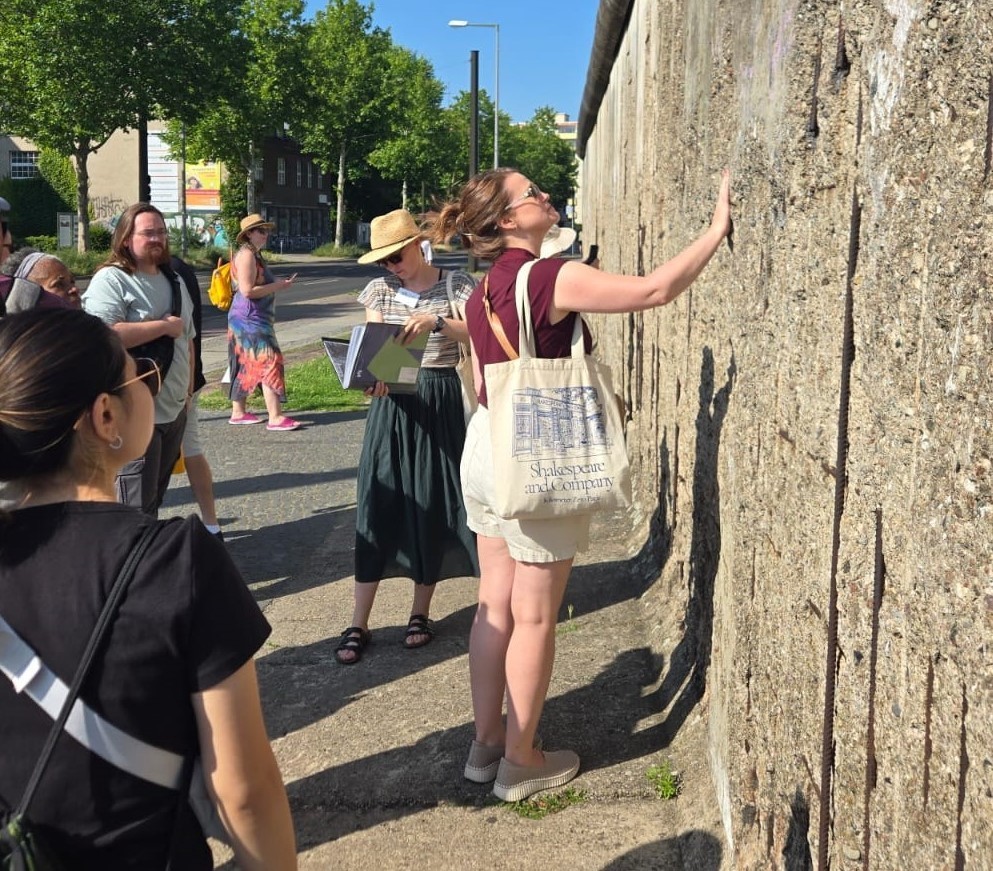Amy Brownlee, USD 376 district librarian and reading teacher, was one of fifteen U.S. teachers who spent 10 days in June exploring Germany through a fully-funded professional development opportunity. The goal of the Transatlantic Study Trip for Teachers was to expose educators to various facets of modern Germany, including its history, culture, government, and education system, in order to strengthen transatlantic relationships.
[Photo above: Brownlee examines a remaining portion of the Berlin Wall at a memorial site.]
The program was coordinated and sponsored by Atlantik-Brücke, a nonpartisan organization. Brücke is the German word for bridge, and the group hosts a variety of programs aimed at building relationships between Germany and people in the U.S. and Canada.
Brownlee’s group visited the cities of Munich, Chemnitz, Dresden, and Berlin as they met with leaders in business, politics, media, and education while learning about the history of each region.
“The most exciting part of the trip for me was visiting German schools and speaking with students and teachers,” Brownlee explained. “I was eager to see how their schools differ from American schools and get ideas on how we can improve.”
Above: Amy Brownlee (standing at left) thanks Dr. Susanne Narciss (at right), Chair of Psychology of Teaching and Learning at Technical University Dresden, for presenting an overview of the teacher training program in Germany. Brownlee gave Dr. Narciss a thank-you gift consisting of Kansas items such as a Sterling mug and lanyard along with Russell Stover chocolates made in Kansas.
The trip included stops at three schools where students in grades 7-11 led the visiting teachers on school tours. Each visit also included a Q&A time between American teachers and German students.
“I was very impressed with all the students I spoke to,” Brownlee said. “Their English was excellent, and they were responsive to questions and eager to exchange ideas. Students were excited to share their love of American pop culture, and more than one student said they increased their English language skills by watching YouTube, TikTok, and movies like The Hunger Games.”
Germany places a strong emphasis on vocational education. German students have the option to leave high school after 10th grade, apply for jobs such as working as a machinist, welder, or electrician, and their employer then pays for their vocational training while students work part-time.
However, Germany lags behind the United States when it comes to serving special education students. While U.S. schools practice inclusion by integrating students with special needs into the regular classroom with their peers, German special education students attend separate schools.
In Germany, most schools do not organize interscholastic activities like sports competitions. Instead, these activities are run through school or community-based clubs.
“I was struck by Germany’s resilience,” Brownlee noted. “We saw magnificent palaces and cathedrals that had been rebuilt after being destroyed by bombs during World War II. During a walking tour in Munich, we saw bullet holes from WWII in a university building that had been purposely left unrepaired to remind people what had happened there. In the German parliament building in Berlin, there is a wall where Russian graffiti is clearly visible to commemorate the Russian occupation and communist rule.”
The Frauenkirche, or Church of our Lady, in Dresden was destroyed by allied bombing in February, 1945. After the fall of Communism in the 1990s, work started to rebuild the church, and it was completed in 2005. Brownlee is pictured in the back row, second from the right.
Germany has rebuilt and moved forward, but they work hard to instill in young people and all citizens the idea of collective responsibility. As guest speaker Dr. Tanja Gouda stated, not all Germans are personally responsible for the crimes committed by Nazis, but they do hold a collective responsibility to remember the events of the past and ensure they never happen again.
“Never again” is the message at Dachau Concentration Camp where Brownlee and her group visited outside of Dresden. The site is now a memorial whose goal is to educate and provide a space for remembrance and healing.
“Visiting Dachau was a sobering but important experience,” Brownlee shared. The site hosts a museum and visitors are able to see barracks and the crematorium along with chapels that aim to bring healing and peace to visitors who come to honor those who died.
Visiting a concentration camp or other memorial site is a common field trip experience for German students as part of their civic education with the goal to create a “culture of remembrance.” In one school, every sixth grader chooses a person who died during the Holocaust. The student learns about the person’s life through archival research and the school holds a ceremony where each student honors a person who lost their life during the Holocaust.
This memorial sculpture on the grounds of Dachau Concentration Camp was designed by Yugoslav artist Nandor Glid. The work depicts human figures ensnared in barbed wire.
“Germany’s history holds a lot of heartbreak, but I also see so much hope and resilience there,” Brownlee noted. “They are working hard to educate children so the mistakes of the past are not repeated.”
Brownlee found the whole experience to be educational and thought-provoking, and she looks forward to sharing what she has learned with her students.
Study trip participants in front of the Karl Marx Monument in Chemnitz, Germany. Brownlee is seated at the far right of the second row.





